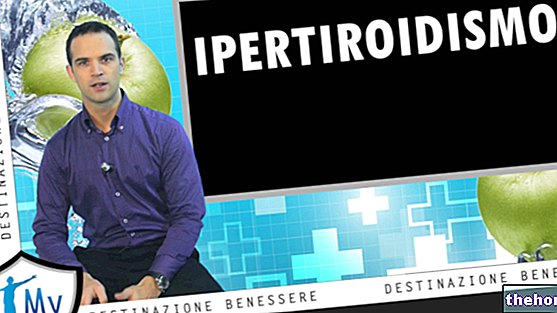The thyroid is a gland located in the anterior region of the neck, in front of and lateral to the larynx and trachea. To give an idea, the thyroid is located more or less at the level of the fifth cervical vertebra, just above the base of the neck, at the cartilage protrusion known as the Adam's apple.
The shape of the thyroid resembles that of the letter H or a butterfly with outstretched wings. The two wings constitute the lobes of the thyroid, respectively right and left, placed on the sides of the larynx. As can be seen from the image, the thyroid lobes are joined together by a sort of bridge that joins them, called the isthmus.
The thyroid is a very small gland; think that overall it measures only 5-8 cm in length and 3-4 cm in width. Its weight is quite variable and depends on some parameters, including nutrition, age and body constitution. In healthy adults, the thyroid weight averages only 20 grams.
Despite its small size, the thyroid performs fundamental functions for the health of the organism, which will be explored in a future video. For the moment, we just need to know that the thyroid is an endocrine gland: this means that it produces hormones, called thyroid hormones. , which control metabolic activities and are responsible for the proper functioning of most of the body's cells.
Structurally, the thyroid is made up of a series of small, spherical vesicles called thyroid follicles. These circular cavities represent the functional units of the thyroid, that is, the smallest elements able to perform the functions to which this gland is responsible. The follicles, in fact, have the task of synthesizing, accumulating and secreting thyroid hormones. Precisely for this reason, each follicle is surrounded by a network of capillaries, into which the hormones produced are poured out when needed.
By examining in detail the structure of a thyroid follicle, we can see that this is bounded by a single layer of cells, called follicular cells or thyrocytes. These cells first produce a protein that acts as a precursor to thyroid hormones, called thyroglobulin. Thyroglobulin is particularly rich in an amino acid called tyrosine. This amino acid is important because thyrocytes selectively take iodine from the blood and transport it to the follicular cavity, where it binds to the tyrosine of thyroglobulin to give rise to the thyroid hormones T3 and T4.
Iodine, as we will see later, is an essential trace element for the function of the thyroid, as it is contained in both thyroid hormones; remember that these hormones affect the activity of many organs and tissues, and have a broad spectrum of action on the metabolism of carbohydrates, fats and proteins and also on growth processes.
In addition to iodine, it is important to remember that selenium also plays a key role in the functioning of the thyroid. Not surprisingly, the amount of this trace element in the gland is higher than in any other organ in the body. Selenium protects thyroid cells from oxidative damage and, at the level of target organs, participates in the reactions that activate thyroid hormones.
Returning to the characteristics of the thyroid follicles, it is important to note that the colloid is present inside them, which is a thick liquid with a high protein concentration. The colloid represents a sort of "warehouse", in which the thyroid hormones are stored and from where they are released according to the needs of the organism. For example, with exposure to cold, the thyroid releases its own hormones, which they act by increasing the basal metabolism, thus raising the oxygen consumption at the cellular level and the body temperature.
The shape of the follicles depends on the functional state of the gland: when it is active and free the thyroid hormones in circulation, it has small follicles, almost empty of the colloid, and cylindrical thyrocytes; if, on the other hand, the thyroid is in a state of relative rest, then the follicles are bulky, the colloid is abundant and the thyrocytes are flattened.
Interleaved between the follicles are the parafollicular cells or C cells, which are responsible for the production of calcitonin. The thyroid, in fact, produces two types of hormones: thyroid hormones, which, as we have seen, regulate the body's metabolism, and calcitonin, which is responsible for maintaining the balance of calcium in the body. From a microbiological point of view, the parafollicular cells are independent and more voluminous than the thyrocytes and never access the follicular lumen.


.jpg)

























